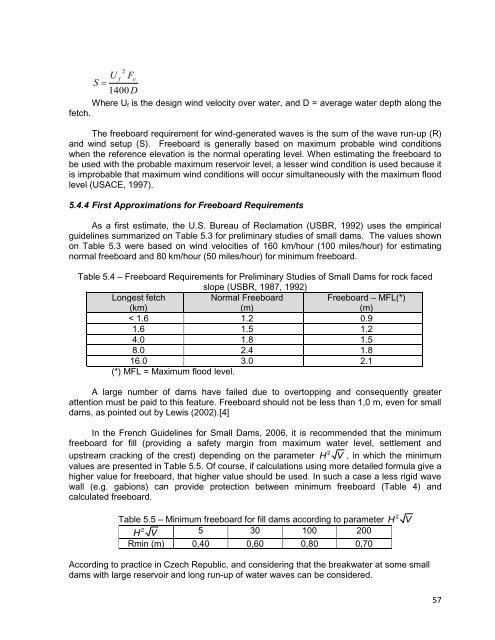SMALL DAMS PETITS BARRAGES
SMALL DAMS PETITS BARRAGES
SMALL DAMS PETITS BARRAGES
- TAGS
- dams
- petits
- barrages
- cbdb.org.br
Create successful ePaper yourself
Turn your PDF publications into a flip-book with our unique Google optimized e-Paper software.
2<br />
U f Fe<br />
S<br />
1400 D<br />
Where Uf is the design wind velocity over water, and D = average water depth along the<br />
fetch.<br />
The freeboard requirement for wind-generated waves is the sum of the wave run-up (R)<br />
and wind setup (S). Freeboard is generally based on maximum probable wind conditions<br />
when the reference elevation is the normal operating level. When estimating the freeboard to<br />
be used with the probable maximum reservoir level, a lesser wind condition is used because it<br />
is improbable that maximum wind conditions will occur simultaneously with the maximum flood<br />
level (USACE, 1997).<br />
5.4.4 First Approximations for Freeboard Requirements<br />
As a first estimate, the U.S. Bureau of Reclamation (USBR, 1992) uses the empirical<br />
guidelines summarized on Table 5.3 for preliminary studies of small dams. The values shown<br />
on Table 5.3 were based on wind velocities of 160 km/hour (100 miles/hour) for estimating<br />
normal freeboard and 80 km/hour (50 miles/hour) for minimum freeboard.<br />
Table 5.4 – Freeboard Requirements for Preliminary Studies of Small Dams for rock faced<br />
slope (USBR, 1987, 1992)<br />
Longest fetch<br />
Normal Freeboard Freeboard – MFL(*)<br />
(km)<br />
(m)<br />
(m)<br />
< 1.6 1.2 0.9<br />
1.6 1.5 1.2<br />
4.0 1.8 1.5<br />
8.0 2.4 1.8<br />
16.0 3.0 2.1<br />
(*) MFL = Maximum flood level.<br />
A large number of dams have failed due to overtopping and consequently greater<br />
attention must be paid to this feature. Freeboard should not be less than 1,0 m, even for small<br />
dams, as pointed out by Lewis (2002).[4]<br />
In the French Guidelines for Small Dams, 2006, it is recommended that the minimum<br />
freeboard for fill (providing a safety margin from maximum water level, settlement and<br />
upstream cracking of the crest) depending on the parameter H V<br />
2<br />
, in which the minimum<br />
values are presented in Table 5.5. Of course, if calculations using more detailed formula give a<br />
higher value for freeboard, that higher value should be used. In such a case a less rigid wave<br />
wall (e.g. gabions) can provide protection between minimum freeboard (Table 4) and<br />
calculated freeboard.<br />
Table 5.5 – Minimum freeboard for fill dams according to parameter H V<br />
2<br />
H V<br />
2<br />
5 30 100 200<br />
Rmin (m) 0,40 0,60 0,80 0,70<br />
According to practice in Czech Republic, and considering that the breakwater at some small<br />
dams with large reservoir and long run-up of water waves can be considered.<br />
57














